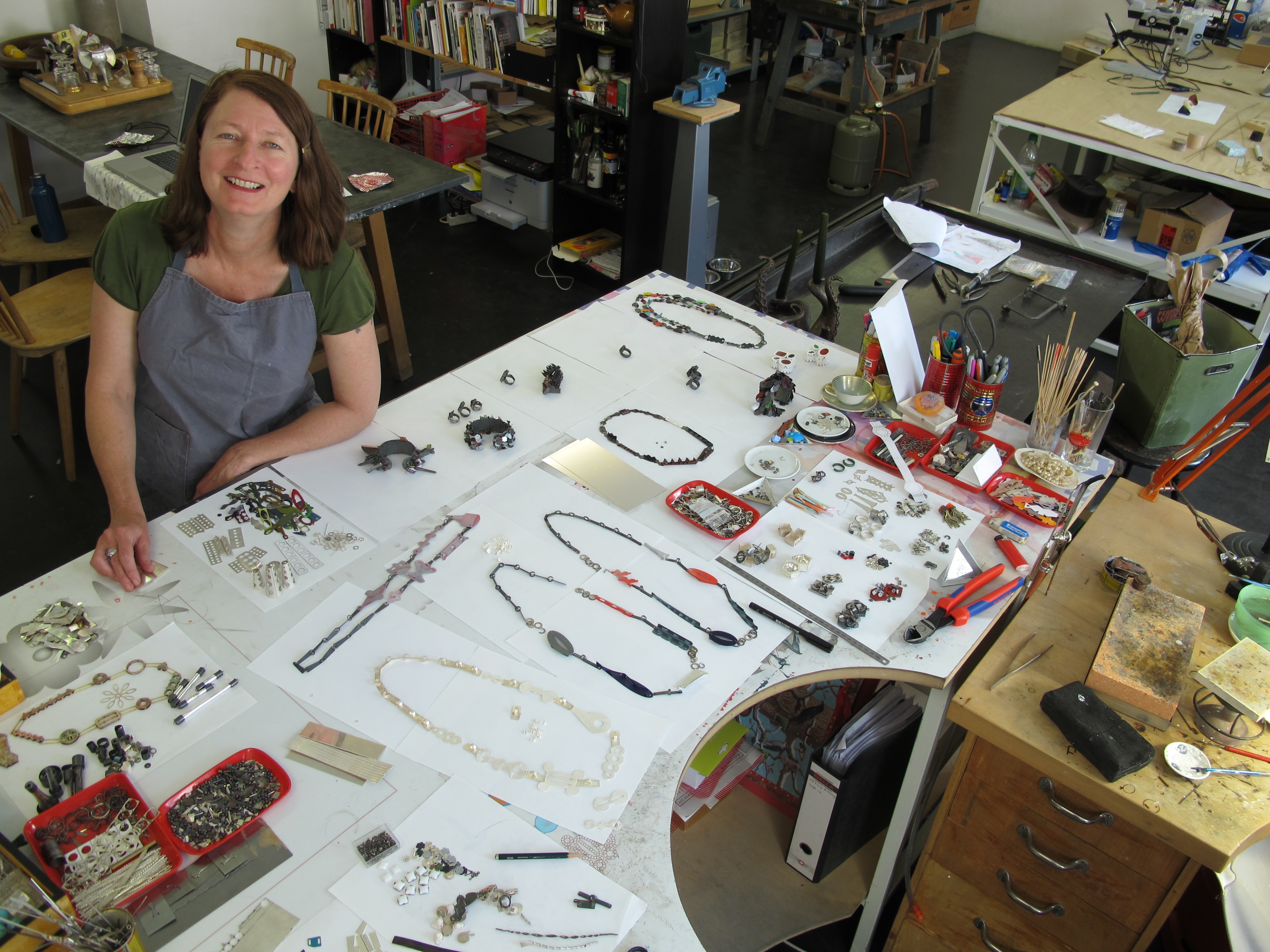
Helen Britton
Créatrice de bijoux
PHOTO : LAURA DEAKIN
Born in Australia, works and lives in Munich
1999
MFA, Curtin University. Western Australia
1999–2003
Akademie of Fine Art, Munich. Class for Jewellery and Objects Prof. Otto Künzli
2002
Established workshop in Munich
2005
Diplom. Akademie of Fine Art, Munich
SOLO EXHIBITIONS (selection)
2013
Heterogene. Gallery Koudijs, Amsterdam
Just Jewellery. Gallery Orfeo, Luxemberg
The Things I See. Neues Museum, Nürnberg, Germany
2012
Industrial 2. Gallery SO, London
Dekorstionswut : Cornucopia. Sienna Gallery, Lenox USA
2011
Industrial, Gallery Funaki, Melbourne Australia
2010
Wet, Glittering Dark, Shiny, Pointy Sharp. Galerie Louise Smit. Amsterdam
2009
Somewhere Else Completely. Bavarian Crafts Council, Munich 13. Gallery Pilartz, Cologne, Germany Decorationswut, Artothek, Munich
2008
Exempla. Internationale Handwerksmesse, Munich
Chaos and Clean Shapes. Klimt02 Gallery Barcellona,; The Things I See. Gallery Funaki. Melbourne
2007
All Else Imaginable. Galerie Louise Smit. Amsterdam; Tier aus der Ferne, Townhall, Erfurt Jewellery Machine, Galerie Beatrice Lang, Bern Switzerland
2006
Urban Paradise Playground. Objectspace, Auckland, New Zealand
2005
Second Nature. Galerie Louise Smit, Amsterdam; Nature Stories. Galerie Biró, Munich Home Ground. FORM, Perth, Australia
2004
Crisscrossing. Galerie Hélène Porée, Paris
2003
Silk purse from a sow’s ear – uus Schyssdrägg Angge mache. Galerie Biró, Munich and Jewelers’ Werk Galerie, Washington D.C.
2002
Pink World. Galerie Louise Smit, Amsterdam; Surprising Worlds, Gallery Funaki, Melbourne
2001
Two Shining Stars from the Southern Hemisphere; OONA – Galerie für Schmuck, Berlin
PUBLIC COLLECTIONS
The Art Gallery of South Australia, Adelaide, Australia; Stedelijk Museum, Amsterdam; Stichting Françoise van den Bosch, Amstelveen; The Netherlands Stedelijk Museum, Amsterdam; Auckland Museum, Auckland, New Zealand; Queensland Art Gallery, Brisbane, Australia; National Gallery of Australia, Canberra; Die Neue Sammlung, Staatliches Museum für angewandte Kunst, Munich (Dauerleihgabe der Danner- Stiftung); The Art Gallery of Western Australia, Perth; Curtin University of Technology, Perth, Australia; Schmuckmuseum im Reuchlinhaus, Pforzheim; The Powerhouse Museum, Sydney, Australia; National Gallery of Victoria, Australia; CODA Museum Amsterdam; Museum of fine Art, Boston, USA; The Metropolitan Museum of Art, NY, USA.
AWARDS / SCHOLARSHIPS
Professional Development Grant, Australia Council (2010); Luitpold Stipendium, City of Munich (2009); Erfurt City Goldsmith (2007); Bavarian State Prize, International Handwerksmesse, Munich (2006); Project grant for Fine Art from the city of Munich (2006); Academy of Fine Art, Munich: DAAD-Prize for Foreign Students (2005); International Handwerksmesse, Munich: Herbert-Hofmann-Prize (2005); Arts WA, Australia: Development Grant (1999); Australia: Chancellors Commendation for research, Curtin University of Technology (1999); The Australia Council: Development Assistance (1999); Förderpreis from the City of Munich (2013).
Preciousness
Materials, resources are precious. Have we forgotten this? Have you ever read the text in Pieter Hugo’s photo documentation « Permanent Error »? Have you listened to the radio documentary « The Children of Sodom and Gomorrah »? When I started making jewellery consciously (I feel like I have always been making jewellery) I was recycling plastics from all kinds of common things, cigarette lighters toothbrushes, because these things were precious to me then for their material qualities. Over 20 years of practice have honed down my interests to recycling components that were made to become jewellery anyway. These components are precious because they represent a human gesture that comes out of necessity, and that is both ancient and humble. It is a gesture that sometimes taps into those great driving themes of humanity; love, anger, joy, aggression, hope and you can’t get more precious than that. And if you answered no to either of those two questions, then make sure you answer yes next time you get asked. Helen Britton
Préciosité
Les matériaux, les ressources sont précieux. L’avons-nous oublié? Avez-vous lu le texte « Permanent Error » de Pieter Hugo? Avez-vous écouté le documentaire radiophonique « Les Enfants de Sodome et Gomorrhe»? Quand j’ai commencé à faire des bijoux consciemment (j’ai l’impression que c’est ce que j’ai toujours fait) j’ai recyclé des plastiques de toutes provenances, -briquets, brosses à dents- parce que ces choses m’ont été précieuses. Plus de 20 années de pratique ont aiguisé mon intérêt pour des matériaux de recyclage qui devaient devenir des bijoux de toute façon. Ces composants sont précieux, car ils représentent un geste humain, geste nécessaire, authentique et humble. Geste surgit de ces grands thèmes de conduite de l’humanité, amour, colère, joie, agressivité, espoir et rien n’est plus précieux que cela. Et si vous avez répondu non à l’une de ces deux questions, alors assurez-vous que vous répondrez oui la prochaine fois que vous vous poserez la question. Helen Britton
(1) Peter Hugo Permanent Error Prestel (April 2011)
ISBN-10 : 3791345206
ISBN-13 :978-3791345208
(2) http//www.abc.net.au/radionational/programs/360/childres-of(Sodom-and-gomorrah/3617306
Cette artiste a participé rue Paul Fort à :
L’exposition « Au-delà du précieux, au-delà des mers » en septembre octobre 2013
